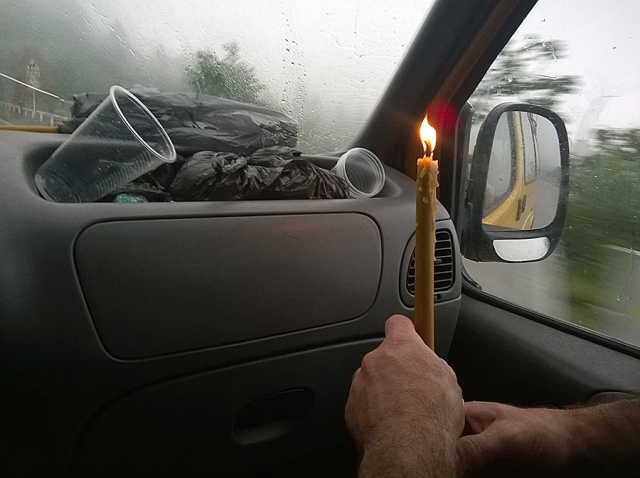Hearse by Candlelight: Zugdidi-Etseri
(I’ll have more to write soon following from last week’s mountain herding article, which is now what you might call a Developing Story. For now, this interlude.)
This place, these people, seem steeped in death, I thought yet again when I heard the news. I was in warm Zugdidi and had just finished some shopping for the latest phase of house renovation and for the shop. This time it was going to be awkward as well as tragic: the dead was my driver’s brother, in hospital not far away, the cause a non-life-threatening medical issue which he had simply ignored and kept quiet about until the then necessary operation was too late. My copious shop stock-up purchases and I would have to travel back up with the corpse and the wailing.
As I look back over the numerous funerals and other death rituals in which it has been my dubious but necessary privilege to partake as a villager in Svaneti, a form emerges. It’s the shape of a necklace, but not one of precious stones; more like lumps of coal strung on barbed wire; and it’s nearly complete. I have been at almost every part, now including the procession of the body from hospital to home, as well as too many pre- and post-funeral events and the great sad day itself. The only thing I lack to finish my grisly collection will be attending someone as they actually die. I suppose I can wait for this.
There is a lot more to Svaneti, but death is one of its seemingly more present realities, alongside glorious landscape beauty and the differences brought by every season, the towers and treasures, the lovely people. Lovely until they die, and then they become human-parodying husks, same as everyone else.
The first mini-feast today was where the Svaneti drivers from Zugdidi gather, near the “Svan Tower”: wine, bread and tinned fish on a thin sheet of plywood. Then we were off, my bags and boxes surreally encircling the coffin in the back of the minivan. The sister, sister-in-law and her young daughter (mercifully sleeping, wrung out by the day’s emotions) sat right beside the coffin, while the brother drove, he and his wife weeping (she all the more as he still had to concentrate on his task). Another unspecified relative sat next to me in the front. He held a long fat Orthodox candle, putting it into a plastic cup when the hot wax got to be enough on his hands.
The candle stayed lit the whole way; something to do with the departed’s entry into heaven, I think. I wasn’t bothered by having a dead body in the car; it was inside the coffin anyway, with the lid on. It was just the emotional outpouring which was hard. Single, too young in his early fifties, and his passing completely unnecessary. I likely have the last photos taken of him, as he and his nephew had helped plough our potato field by oxen in mid-spring, with me documenting. Now I know a little of how the people feel who accompany the Olympic Flame as it travels from Greece to wherever in the world every two years: or do I?
We stopped several times on the way, as friends and relatives heard the news and wanted to pay respects. The first stop was about halfway up, someone waiting outside a roadside cafe. Then a small car, which had come down about 40 km just to meet us, its driver and passengers men, all sobbing. A minivan full of the village’s men was next, a bit closer to home. Each time we stopped, the men exited, brief toasts were made, the sister-in-law poured out her anguish in a loud voice.
Near the dead man’s home, they took his coffin out to carry it to his poor waiting elderly mother by hand. His teenage nephew drove me and my goods home, and we were done for the day. Now the body will be on display (refrigerated) in a room filled with wailing women, until funeral day, just under a week from now. Everyone who comes will be able to eat and drink to the memory of the departed.
The biggest feast will be on the day of the funeral, once the procession has carried the coffin to the local hamlet’s cemetery and buried it. Then, every Saturday until the ormotsi (40 days from death feast), another feast. Ormotsi, and then tslistavi, a year after death, to wrap it up formally. All contributed to financially by everyone who takes part (hopefully 100%), and labor-wise the same. Do you see where my feeling comes from, that Svaneti is focused on death?
Tony Hanmer runs the “Svaneti Renaissance” Facebook group, now with over 1000 members, at
www.facebook.com/groups/SvanetiRenaissance/ .
He and his wife also run their own guest house in Etseri:
www.facebook.com/hanmer.house.svaneti
Tony Hanmer












